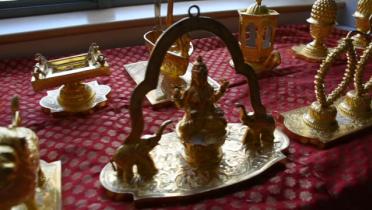Jain Center of America, Queens, New York: Overview
This notion that “all Jains are Gujaratis” is overshadowing the true representation of who Jains are and the religion Jainism. As part of Brooklyn Arts Council's Citizen Folklife initiative, Smrita Jain does fieldwork in order clear up this misconception.
Nearly all Hindu temples and community centers whether located in India or outside, are created with one main purpose – to bring people together and develop a community, to instill in them the feeling of belongingness and treating each member as a family. The saying “the family that eats and prays together, stays together” remains the main objective of many Hindu temples and community center, including Jain Center of America.
At the Jain Center of America, the community prays, learns and practices their faith under one roof. No matter which sub-sect of Jainism you may belong to, you would always be welcomed in this space as a family.
Most, if not all, places in the Center are communal including the area where members eat. To bring a sense of togetherness and oneness, everyone eats the same food, at the same time. The food is always served free of cost. Anyone from outside the Jain community can also partake the food, however, a small donation is always welcomed. Growing up in a closed knit Jain family, I can personally relate to this space of the Jain Center of America.
—What is your name? Smrita Jain. Oh! So you must be guju? —NO! I am NOT Gujarati. I am just plain simple Jain from New Delhi.
I am always asked this question the moment another Indian, living in the USA, learns about my last name, Jain.
Even though I laugh every time I am asked that question, it always seems very unsettling to me. And the reason why this question comes up is only that, it is preconceived and taken for granted that Jains primarily are Gujaratis, a northwestern state of India and there are many Jains from Gujarat. But the fact is that the state of Maharashtra has the most Jains living.
There are Jain temples all over India, but the largest and the biggest Jain Dilwara temple actually exists in Rajasthan (India’s largest state), which shares the borders with Punjab to the north; Haryana and Uttar Pradesh to the northeast; Madhya Pradesh to the southeast; Gujarat to the southwest, and Pakistan to the northwest.
This notion that “all Jains are Gujaratis” is overshadowing the true representation of who Jains are and the religion Jainism.
With my video presentation of the most basic practice of how the Jain priest performs the daily rituals and through his explanation of who Jains are no matter which state they belong to, will hopefully clear this misconception.

